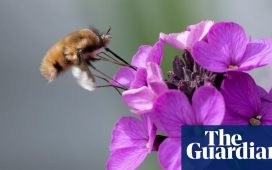Record-breaking sunshine has encouraged midsummer butterflies to emerge unusually early, with dozens of species appearing a month before their usual flight season.
Butterflies that usually fill meadows and woods in July, including the ringlet, the marbled white, dark green fritillary and the silver-washed fritillary have been widely spotted during the sunniest spring since records began in 1929.
Experts are hailing it as – so far – the best summer for butterflies in nearly 25 years, with an abundance of both common species such as the small heath and endangered ones such as the heath fritillary, a notoriously sedentary butterfly which this year is being found on new sites across Exmoor.
Matthew Oates, the author of His Imperial Majesty: A Natural History of the Purple Emperor, a new book about the elusive Apatura iris, has seen 10 species earlier this year than during any other summer for the last 50 years.

“Butterflies are climate and weather opportunists par excellence,” he said. “Don’t write a butterfly book – climate change will make it instantly out-of-date.”
Oates has spotted the meadow brown, large blue, high brown fritillary, dark green fritillary, silver-washed fritillary, comma, ringlet, marbled white, silver-studded blue and purple hairstreak earlier than any season since he began recording butterflies in 1971.
The early emergences are driven by warm dry weather, but global heating is causing drastic revisions to butterfly flight seasons.

The purple hairstreak and the gatekeeper – both usually July butterflies – emerged this week. Only three of Britain’s 59 native butterfly species have yet to take flight, according to Butterfly Conservation: the chalkhill blue, the brown hairstreak and the purple emperor.
The latter was once rarely seen before 1 July, but despite the weather turning unsettled this week the species is expected to beat its earliest-ever sighting of 10 June 1893, when pupils at Marlborough College caught one in woods beside the school.
In the 1980s, the treetop-dwelling purple emperor was confined to woods in the home counties but, according to Oates’s study, climate change – and new spotting techniques – have led to the previously overlooked iridescent purple insect being discovered across the Midlands and East Anglia.

Oates predicts it will be seen this year for the first time in decades in Wales, Herefordshire and Shropshire and possibly in Yorkshire, where it has never before been recorded. Many species, including the Essex skipper and marbled white, are moving northwards with global heating.
Butterflies may appear to be booming in the short-term but some species’ life cycles risk falling out of sync with the plants that their caterpillars depend upon for food.
Oates said: “I worry that the purple emperor can get out of sync with a growth phase in sallow leaves. If we have an early spring followed by a weather collapse, the caterpillars perish – but the hard science needs doing on this.”

With butterflies emerging so early, many species could go on to have a second or third brood in the autumn. This is not necessarily a boon for some because it can create a “developmental trap” with the autumn butterflies’ offspring unable to cycle through egg and caterpillar stages so late in the year. According to Oates, the demise of the wall brown butterfly is linked to a late brood in which the species’ offspring die off as winter sets in.
This summer is proving good for butterflies so far because it follows two hot, sunny summers, allowing their numbers to build up over the seasons.
“Truly great butterfly years are the third good summer in a row – so the abundance of butterflies of in 1976 was helped by fine summers in 74 and 75,” said Oates.
“This century we’ve had good summers in 03, 06, 09, and 2013 but not three in a row. If we get a sequence we could be in business. But if the jet stream has suddenly jumped south and we’ve got six to eight weeks of rubbish weather then that won’t happen and we could have had our summer – it was called lockdown.”







